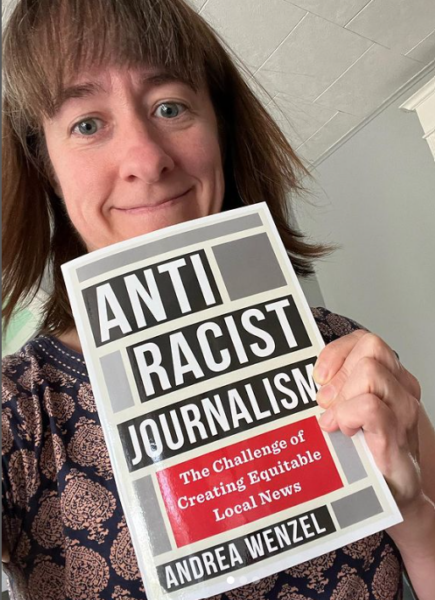The Listening Post Collective recently caught up with Andrea Wenzel, the author of the new book, Antiracist Journalism: The Challenge of Creating Equitable Local News. Wenzel is a Professor at Temple University’s Lew Klein College of Media and Communication, she’s also a former project advisor at LPC parent org Internews, where she helped develop local media houses in Sri Lanka.
Em Hilberer chatted with Wenzel about her book as part of our LPC IG Live series. Here’s an excerpt from their conversation.
What inspired you to start this work thinking and writing about structural racism in US newsrooms?
I used to work at WBEZ in Chicago, and I worked for about 15 years in public media, and then international media development work. I would look around and see a bunch of people who look like me in the newsroom. Often in a city and communities that didn’t, that were very diverse, and yet that diversity often wasn’t reflected within our news organizations, it also often wasn’t reflected within our audiences. So that was one of the things that raised a lot of questions for me and made me want to think more about how this could be different and what it would mean and look like to have more equitable and community engaged journalism. In conversations I had with people, they also shared concerns that even if they were doing some really interesting and innovative projects locally, they might still be feeling that their community was being harmed by narratives that were heard from larger news organizations, about their communities.
Can you talk a bit about accountability infrastructure, and what that might look like for local newsrooms?
I just basically mean any sort of system program or structure that’s trying to hold folks with more power accountable to those with plans [to address representation in newsrooms]. And that might mean holding the organization accountable, holding a senior white editor accountable, holding the CEO accountable, and holding them accountable to BIPOC journalists and communities. So it would mean things like developing a system for journalists to track the people that they interview, the sources that they include in their stories, and then finding ways not just to do that, but hold the reporters and editors accountable for doing that, and for making progress on how they do that.
When the former VP of news at WHYY (Philadelphia’s NPR station) Sandra Clark started this work and set this up and made it part of people’s performance reviews, that sort of gave it some teeth. So that’s one example of accountability infrastructure.
Another example that I talked about in my book was a hyperlocal outlet called Kensington Voice, which is a really, really interesting and important outlet here in Philadelphia. They have a community-led board, and that’s the board with governance. It is not just like an advisory group. They have oversight over budget over our leadership. That’s a really important example of what news organizations can do to try to hold themselves accountable to communities because in this case, the board is entirely Kensington residents, and they do different things in the community but they have an opportunity to offer guidance over their activities and their mission and vision.
Do you have any tips for people that are interested in getting involved in this work in their own newsroom?
One of the big things is just like trying to take stock of where you’re at. Be mindful of your own positionality in this process. I identify as a non-Hispanic, white, cisgender former journalist, and so I have to take stock of where I am and what I can see and what I can’t see. I can’t speak on behalf of my colleagues of color, I can try to do what I can and try to be accountable to them. I think there’s a role for people like me, there’s also you know, depending what power you have to change where you are in organization, or maybe you’re a new journalist starting out, there’s going to be different challenges. There’s also going to be challenges if you’re a journalist of color. It brings a sort of emotional labor that could potentially be traumatizing.
It’s hard to be prescriptive with “here’s what you can do.” That being said, for organizations who can kind of do sort of mapping of where you’re at, you can look for ways to take stock of your own coverage and your relationships with communities. You can do things like look at who you’re interviewing in stories and what roles they’re playing. Think about how people are framed into certain stories.
The Philadelphia Inquirer did a lot of work in response to a terrible racist headline; they had a very big DEI process. They put together an anti-racist workflow guide, which had a number of questions you could ask at different points in the process of stories.
What was your favorite part about writing this book? What have you taken away from this experience?
My favorite part about this experience was getting to meet people who are doing this work in different spaces. And, you know, including people who are having a tough time, but who were maybe in a large organization and trying to steer a giant ship in a different direction. There are just so many people who are trying different things. Whether they’re working in a new startup or in an existing organization, like they are great people [doing this work]
It’s just a challenge to look at how to change institutions, how to put in some structural support for people so that when somebody leaves, things don’t go off the rails.
I got to meet some amazing people and learn from them. And people are really patient with me. And I continue to make mistakes in this work myself. People have held me accountable, but also have been really kind.
